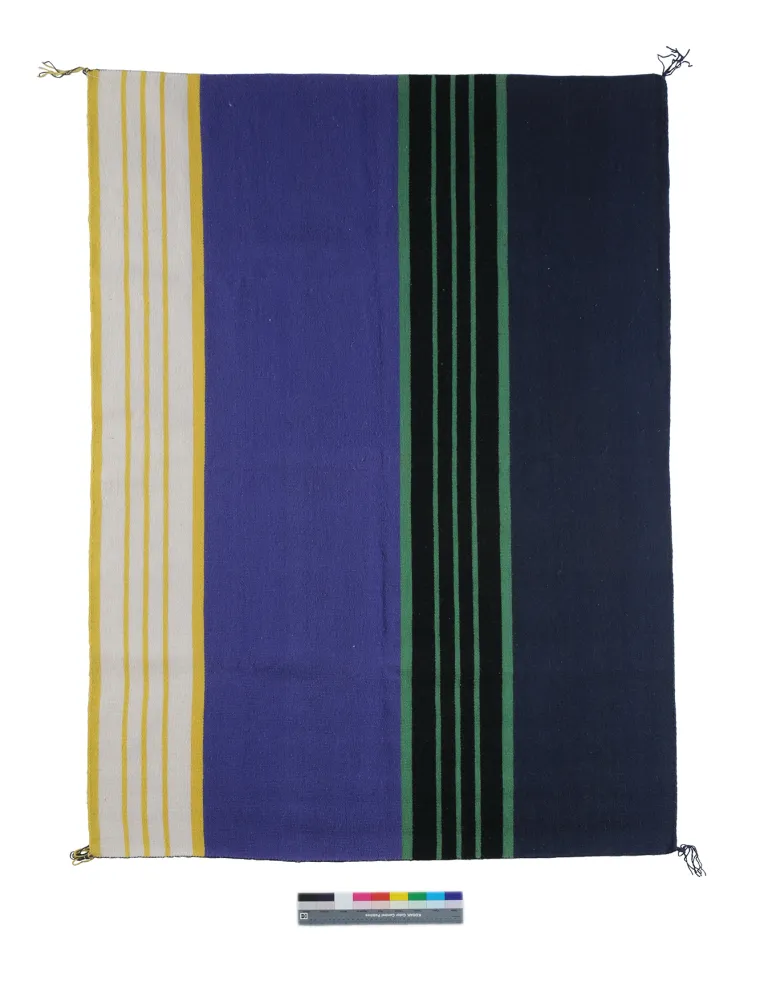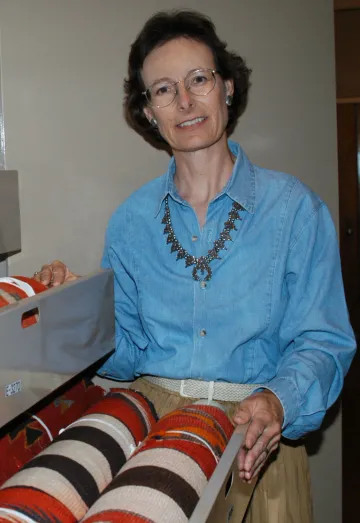
Silent Adios II
1981
Navajo
Originally commissioned by Gloria F. Ross and woven by Mary Lee Henderson Begay from a design by Kenneth Noland
Navajo
Ganado, Arizona
Textile—commercial single-ply sheep’s wool, synthetic dyes, tapestry weave
Length: 51 in. (129.5 cm.), Width: 78 in. (198 cm.)
Gift of Robert and Ruth Vogele, Chicago, Illinois, 2009
(ASM Catalog No. 2009-582-1)

Text by Dr. Ann Lane Hedlund, retired Curator of Ethnology, December 7, 2010
Each year from 1979 to 1996, Gloria F. Ross (GFR) traveled from New York to the American Southwest and commissioned Native American weavers to work from designs by Kenneth Noland, the well-known East Coast painter of bold abstractions. This is one of many collaborations described in my new book, Gloria F. Ross & Modern Tapestry, which traces Ross’s 34-year career in tapestry making from New York to Scotland, France, and the southwestern U.S.
Woven all over the world, the GFR Tapestries represent a series of intensive negotiations between designers, weavers, dyers, architects, and Gloria Ross, the organizer and financer of these projects. They follow a classic European tradition: a patron selects a famous artist to design a tapestry and commissions skilled weavers to execute the hand-woven panels. In the past, tapestries served to adorn castles and cathedrals; in modern times, tapestries have become a status-marker for corporate and private collectors.
I chose this textile because its exceptional story is featured in Gloria F. Ross & Modern Tapestry and it is the only GFR-related textile owned by Arizona State Museum. It also represents a serious dilemma for Ross’s work and an example of how projects can go awry.
The story begins: From 1979 to 1996, master weaver Mary Lee Henderson Begay wove eleven successful tapestries at Ross’s request, each from small paintings created especially for her by Kenneth Noland. In 1981 she wove this striped rug from a painting code-named “D.” An earlier striped work was named “Silent Adios,” so this became known as “Silent Adios II.” When it was completed and shipped to New York, Ross and Noland rejected the work because it didn’t exactly match Noland’s design, even though it was exceptionally well-woven in a traditional Navajo manner with top-quality materials. As Ross explained, “. . . the colors were not right [a blue was too purple] and one of the wide bands was not as wide as it should have been.”
BUT the tale goes on: For several decades Mary Lee Begay had worked as a weaving demonstrator at Hubbell Trading Post in Ganado, Arizona. She wove “Silent Adios II” at the Post and, when it was turned down, Ross agreed to its sale without mentioning her or Noland’s names. Store manager Al Grieve entered it into a regional art fair where it won first prize for innovative design! Then it joined the other more traditional Navajo rugs in Hubbell’s salesroom.
And so it continues: Almost immediately the tapestry was purchased by sharp-eyed Chicago collectors Robert and Ruth Vogele, known for their keen interest in modern design and folk art. Despite its “flaws,” Robert reported, “I was intrigued by the rug as a visual object—a wonderful contemporary painting.” In 2009, after a visit to Arizona, the Vogeles donated the tapestry to the Arizona State Museum.
A happy ending: Each of the ninety-six GFR Tapestry projects described in my book raises questions about the nature of collaborative and trans-national art ventures. How were decisions made and who took responsibility for the results? Whose name gets top notice? How are mistakes dealt with? Who is sometimes left “holding the bag”? Each project answers these questions in different ways. At times (like this one) the artist's intent was paramount; sometimes weavers had more leeway to interpret the designs; and at other times, team members shared influence. Most projects were successful and only a few failed. By joining the museum’s permanent collection and by illustrating traditional skills and an important contemporary story, “Silent Adios II,” along with its expert weaver Mary Lee Henderson Begay, finally takes the spotlight!
Reference
Hedlund, Ann Lane
- 2010 Gloria F. Ross & Modern Tapestry. New Haven, CT: Yale University Press, in association with Arizona State Museum.





